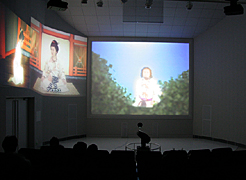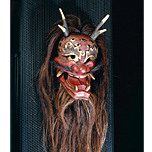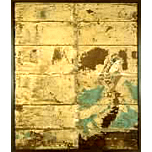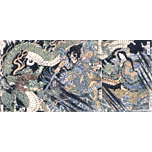Shimane Museum of Ancient Izumo will be closed from April 2025 to September 2026 (tentative) due to seismic retrofitting and other renovation works.
Mythology Theater and the Corridor of Myth and Legend
The Izumo region of Shimane Prefecture is often called the “land of the gods” or “the homeland of myth” because it is the setting for many of Japan’s oldest myths. In this section of the museum, visitors can learn about myths set in ancient Izumo and the deities worshipped at Izumo Grand Shrine. The theater shows a rotation of four short films (approximately 20 minutes each). English summaries of the films are available on handheld electronic devices provided free of charge at the theater entrance.
The four short films are entitled “Myths of Ōkuninushi,” “Myths of Susanoo,” “Myths of the Izumo Province,” and “The Medieval Serpent.” The first three are based on three eighth-century texts: the Kojiki (Record of Ancient Matters), the Nihon shoki (Chronicle of Japan), and the Izumo no kuni fudoki (Gazetteer of Izumo Province). “The Medieval Serpent” is based on a tale written in 1523.
Exhibits in the Corridor of Myth and Legend explore how these myths have been transmitted over time, including textual commentaries and artwork depicting their characters and scenes. Fearsome masks and a huge, dragon-like serpent adorn the walls and ceiling of the corridor. Costumes and props similar to these are used to reenact the myths during performances of kagura, a form of sacred dance. The dragon-like creature suspended from the ceiling is the Yamata no Orochi (“eight-headed serpent”), the monster slain by the deity Susanoo no Mikoto when he first arrived in Izumo. The details of this saga—as well as the creation of Japan itself—are depicted in the film “Myths of Susanoo.”
(This English-language text was created by the Japanese Tourism Agency.)

Video Program
(1)Myths of Susanoo
(2)Myths of Ōkuninushi
(3)The Medieval Serpent
(4)Myths of the Izumo Province
(1)Myths as holy story during the sacred rites
Changes in interpretation of myth and the setting where myths were told, such as Kagura(sacred music and dance) and Kanyogoto ritual (inaugural ceremony of the Izumo Kokuso) are introduced. Compare these with some other myths set in Kitatsu-umi, or the Japan sea, to discover more about the meaning of ancient myth.



(2)Exploration of the world of myths
Get inside the myths by taking a look at the traditional places, objects, and how interpretation of the myths has changed over time. Also read firsthand the books containing ancient myths.
|
Shimane Museum of Ancient Izumo 99-4 kizuki-Higashi, Taisha, Izumo City, Shimane Prefecture, 699-0701 JAPAN TEL +81-853-53-8600/FAX +81-853-53-5350 | Copyright © 2007 Shimane Museum of Ancient Izumo. All rights reserved. |
